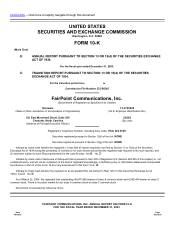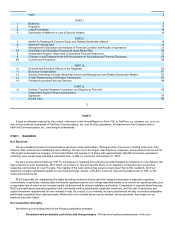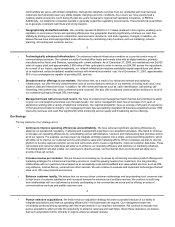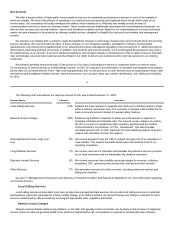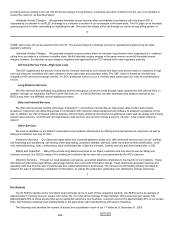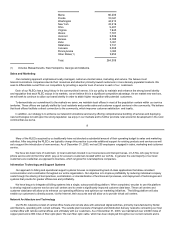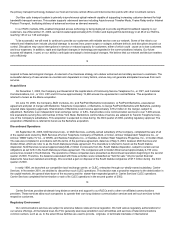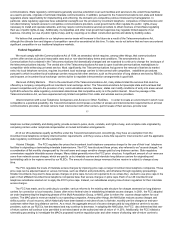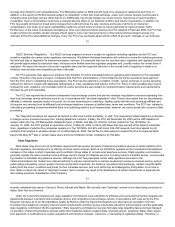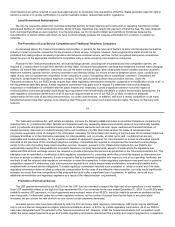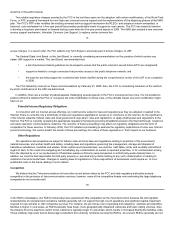FairPoint Communications 2003 Annual Report Download - page 11
Download and view the complete annual report
Please find page 11 of the 2003 FairPoint Communications annual report below. You can navigate through the pages in the report by either clicking on the pages listed below, or by using the keyword search tool below to find specific information within the annual report.
would be in the public interest.
Two notable regulatory changes enacted by the FCC in the last three years are the adoption, with certain modifications, of the Rural Task
Force, or RTF, proposed framework for rural high-cost universal service support and the implementation of the beginning phases of the MAG
plan. The FCC's RTF order modifies the existing universal service support mechanism for RLECs and adopts an interim embedded, or
historical, cost mechanism for a five-year period that provides predictable levels of support to rural carriers. The FCC has stated its intention
to develop a long-term plan based on forward-looking costs when the five-year period expires in 2006. The MAG plan created a new universal
service support mechanism, Interstate Common Line Support, to replace carrier common line
15
access charges. In a recent order, the FCC added Long Term Support, previously part of access charges, to USF.
The Federal State Joint Board, or the Joint Board, is currently considering recommendations on the question of which carriers can
obtain USF support in a market. The Joint Board recommended that:
•a set of permissive federal guidelines be developed to ensure that the public interest is served before ETCs are designated;
•support be limited to a single connection that provides access to the public telephone network; and
•the basis for providing support be considered and further clarified during the comprehensive review of the USF to be completed
in 2006.
The FCC statutorily must act on these recommendations by February 27, 2005. Also, the FCC is considering resolution of the method
by which contributions to the USF are determined.
In addition, there are a number of judicial appeals challenging several aspects of the FCC's universal service rules. It is not possible to
predict at this time whether the FCC or Congress will order modification to those rules, or the ultimate impact any such modification might
have on us.
In connection with our Internet access offerings, we could become subject to laws and regulations as they are adopted or applied to the
Internet. There is currently only a small body of laws and regulations applicable to access to or commerce on the Internet. As the significance
of the Internet expands, federal, state and local governments may adopt rules and regulations, or apply existing laws and regulations to the
Internet. The FCC is currently reviewing the appropriate regulatory framework governing broadband access to the Internet through telephone
and cable operators' communications networks. The outcome of these proceedings may affect our regulatory obligations and the form of
competition for these services. In February 2004, the FCC initiated a proceeding to examine the regulatory implications of voice over Internet
protocol technology. We cannot predict the results of these proceedings, the nature of these regulations or their impact on our business.
Our operations and properties are subject to federal, state and local laws and regulations relating to protection of the environment,
natural resources, and worker health and safety, including laws and regulations governing the management, storage and disposal of
hazardous substances, materials and wastes. Under certain environmental laws, we could be held liable, jointly and severally and without
regard to fault, for the costs of investigating and remediating any contamination at owned or operated properties, or for contamination arising
from the disposal by us or our predecessors of hazardous wastes at formerly owned properties or at third party waste disposal sites. In
addition, we could be held responsible for third party property or personal injury claims relating to any such contamination or relating to
violations of environmental laws. Changes in existing laws or regulations or future acquisitions of businesses could require us to incur
substantial costs in the future relating to such matters.
We believe that the Telecommunications Act and other recent actions taken by the FCC and state regulatory authorities promote
competition in the provision of telecommunications services; however, many of the competitive threats now confronting the large telephone
companies do not currently exist
16
in the RLEC marketplace. Our RLECs historically have experienced little competition as the incumbent carrier because the demographic
characteristics of rural telecommunications markets generally will not support the high cost of operations and significant capital investment
required for new entrants to offer competitive services. For instance, the per minute cost of operating both telephone switches and interoffice
facilities is higher in rural areas, as RLECs typically have fewer, more geographically dispersed customers and lower calling volumes. Also,
the distance from the telephone switch to the customer is typically longer in rural areas, which results in increased distribution facilities costs.
These relatively high costs tend to discourage competitors from entering territories serviced by RLECs. As a result, RLECs generally are not

